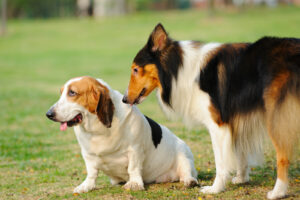Barks Blog
The Power of Desensitization

Desensitization is a tool I use in my armory virtually every day – it’s ultra powerful, versatile and it works well, that is IF it’s applied correctly! Here I’m going to take a look at this ‘behaviour fixer’ in a bit more detail because if it’s worked with in the right way, you’re just not going to get the results you want and even worse, the dog may relapse.
What’s Desensitization Anyway?
I have a definition that I use for Desensitization or (to give it it’s full name) Systematic Desensitization.
The process involves a very gradual and repeated presentation of the stimulus the animal is reacting to, in a non-threatening way, until they become habituated to it.
I like to keep this definition as clear as possible. By ‘reactive’, insert; fearful, anxious, over-aroused, excitable etc.
What Behaviours Can It Be Used For?
Desensitization is a very versatile tool. Probably most commonly used for disorders involving fear and anxiety but I like to use it to assist dogs who become very over-excited or over-stimulated and aroused.
Explaining Desensitization and Making It Work
To make the process work, owners have to really understand the process – let’s take the example of a fear stimulus, say another dog. Most of my clients have read information and tried to embark upon some desensitization themselves, so they may have tried treating their dogs every time another dogs passes. The trouble is that they find that their dog will be OK sometimes and others not, or will still be horrendous every single time and they can’t see why this is.
Dilute and divide the stimulus
Firstly (in the example above) you have to work out exactly what the dog is afraid of – we decided it was other dogs. Now though, it’s not as simple as simply exposing your dog to other dogs, that may just involve flooding and make the situation worse. Think about different elements of that stimulus – dogs vocalizing, dogs standing still, different shapes/sizes/colors/breeds, dogs moving, dogs running, dogs coming closer. To achieve success you will need to desensitize to all of these separate elements before you bring them together as ‘one whole dog’. That is what many owners do not appreciate – it’s a time involving process. So we may start with sound desensitization to dog vocalizations and no animal present, then bring in a stuffed fake dog at ever decreasing distance, then a real dog at various desensitization stages, different breeds, colors, stationary, moving dogs etc.
Threshold is crucial
How many times do I find myself saying this! This has got to be the major reason why desensitization fails. It’s human nature to push, push, push. We want to succeed and we just have to push that little bit too far….and then it’s ruined! Threshold refers to the distance your dog has to be (in the example above) from the fear target, in order to be relaxed and happy and able to respond to you – this is what you want. If your dog begins to react, he is over threshold and you must increase distance – think of it as a ‘comfort distance’. Too often I see owners do the reverse – get close to the target, make their dog react and then do something – this is wrong. Dogs must be fear free, happy and relaxed at all times.
Counterconditioning Is Key
When you are conducting desensitization, you will also be carrying this procedure out. I like to define the process as:
Counterconditioning involves replacing the negative association of the stimulus the animal is reacting to, with a positive one. Desensitization and counter-conditioning procedures are often implemented together.
So here, depending upon your dog’s motivation, you may be introducing something like food, praise, play in combination with the desensitization process, ensuring your dog is under threshold and in the presence of the particular stimulus. Taking the example of the dog/fear stimulus above, it is crucial that delivery is accurate, so the dog would see the stimulus, you would immediately begin delivery of praise/feeding/play and as soon as the dog/fear stimulus had disappeared, you would stop the delivery. It is crucial that the delivery of the reward is contingent on the appearance of the dog/fear stimulus – classical conditioning. With expert timing, dogs quickly learn the connection between stimulus and reward and begin to anticipate. I then begin to add in newer substitute behaviours which will overlap the previously inappropriate response. The dog, with practice becomes increasingly more proficient at performing this skillset.
Desensitization and Counterconditioning are powerful tools for a wide array of behavioral issues, but they must be used with care and are best introduced with the guidance of a qualified behaviorist. It is so rewarding to see the results they can provide, even from the most severe behavioral issues.

